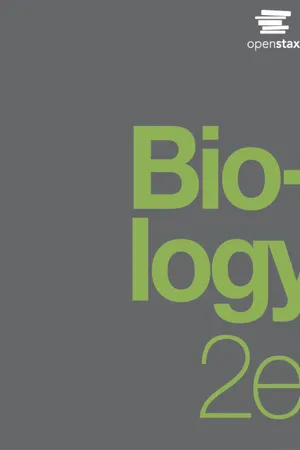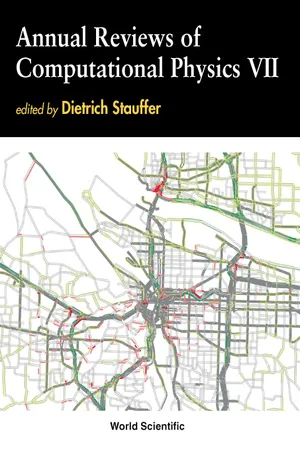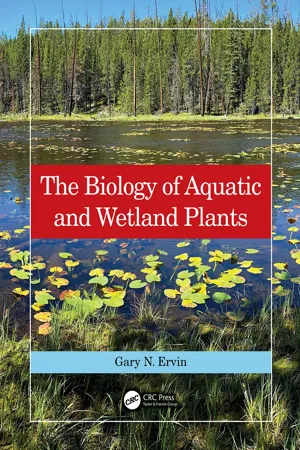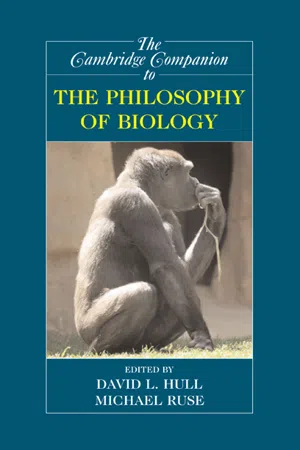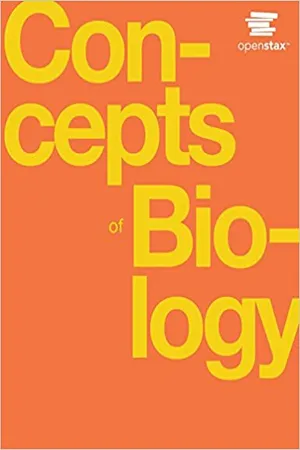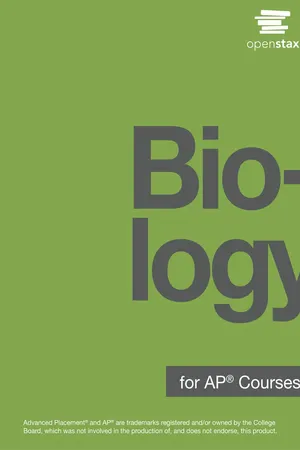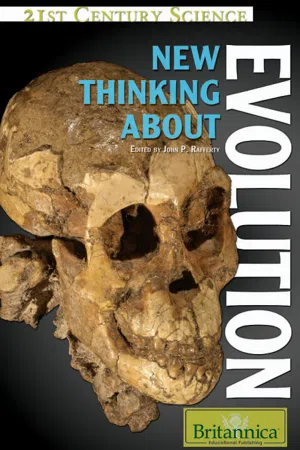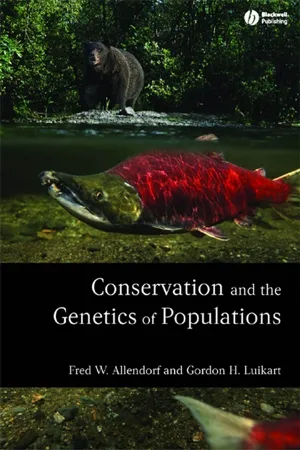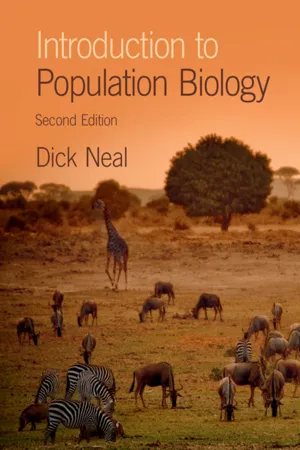Biological Sciences
Evolution of Populations
The evolution of populations refers to the changes in the genetic makeup of a group of organisms over time. It involves processes such as natural selection, genetic drift, gene flow, and mutation, which can lead to changes in the frequency of certain traits within a population. Understanding the mechanisms of evolution is crucial for studying the diversity and adaptation of living organisms.
Written by Perlego with AI-assistance
Related key terms
1 of 5
11 Key excerpts on "Evolution of Populations"
- eBook - PDF
- Mary Ann Clark, Jung Choi, Matthew Douglas(Authors)
- 2018(Publication Date)
- Openstax(Publisher)
19 | THE Evolution of Populations Figure 19.1 Living things may be single-celled or complex, multicellular organisms. They may be plants, animals, fungi, bacteria, or archaea. This diversity results from evolution. (credit "wolf": modification of work by Gary Kramer; credit "coral": modification of work by William Harrigan, NOAA; credit "river": modification of work by Vojtěch Dostál; credit "fish" modification of work by Christian Mehlführer; credit "mushroom": modification of work by Cory Zanker; credit "tree": modification of work by Joseph Kranak; credit "bee": modification of work by Cory Zanker) Chapter Outline 19.1: Population Evolution 19.2: Population Genetics 19.3: Adaptive Evolution Introduction All life on Earth is related. Evolutionary theory states that humans, beetles, plants, and bacteria all share a common ancestor, but that millions of years of evolution have shaped each of these organisms into the forms we see today. Scientists consider evolution a key concept to understanding life. It is one of the most dominant evolutionary forces. Natural selection acts to promote traits and behaviors that increase an organism’s chances of survival and reproduction, while eliminating those traits and behaviors that are detrimental to the organism. However, natural selection can only, as its name implies, select—it cannot create. We can attribute novel traits and behaviors to another evolutionary force—mutation. Mutation and other sources of variation among individuals, as well as the evolutionary forces that act upon them, alter populations and species. This combination of processes has led to the world of life we see today. Chapter 19 | The Evolution of Populations 517 - eBook - PDF
- Dietrich Stauffer(Author)
- 2000(Publication Date)
- World Scientific(Publisher)
But first of all, we must define our subject more precisely. Evolution proceeds via mutation and selection. In this shortened version, the understanding of biological evolution has entered everyday knowledge. Of course, it's too short to be correct: actually, evolution consists of a fair number of elementary processes, i.e. mutation, selection, recombination, migration, and drift (i.e. fluctuations due to finite population size), and it is not even Biological Evolution Through Mutation, Selection, and ... 205 decided whether mutation and selection are the most important ones. They are, however, weighty factors, and may serve as a case study of evolution as such. For the conceptual issues related to the notion of evolution, we refer the reader to Endler. 40 We shall restrict ourselves to models of mutation and selection, without and with genetic drift. That is, we must — regrettingly — exclude the fas-cinating topic of recombination, and, with it, the evolution and maintenance of sexual reproduction. Fortunately, there is a recent review available on this topic. 43 But due to finite time, space, and knowledge of the authors, the field must be narrowed down even further. We shall concentrate on models which describe genetic variation within single populations. This excludes macroevo-lution, speciation, and phylogeny (which are concerned with variation between populations), as well as adaptive walks (which describe species as genetically homogeneous entities). For the same reasons, models of coevolution will not be considered here. For a simple model of interacting populations, we refer to Bagnoli and Bezzi (this volume). In order to provide the uninitiated with some flavour of the field, we will set out with a few relevant questions before embarking on the basic models of population genetics. The latter describe the evolution of the composition of a population under the joint action of mutation, selection, and drift, and will provide the foundations on which to build. - eBook - ePub
- Gary N. Ervin(Author)
- 2023(Publication Date)
- CRC Press(Publisher)
Why does that plant grow there? —could have different answers in different locations, even within a single species. Furthermore, the environmental and genetic factors responsible for the variation that we sometimes see among populations can lead to similar variation within populations. This latter process requires a certain amount of environmental and genetic heterogeneity among microhabitats and among individuals across the space that the population occupies. Interactions among individuals within a population and between the individuals and their environment drive changes in genetic composition over time, through such processes as selection and gene flow. Outcomes of those interactions drive both short- and longer-term Evolution of Populations, and thus collectively, the species, giving rise to the diversity of species and environmental adaptations that we have seen in the first eight chapters of this book.In this chapter, we will learn about approaches used to examine population-level dynamics of plant species. We begin in the following section with an overview of population biology and progress ultimately to ecological and evolutionary processes responsible for the patterns of aquatic and wetland plant diversity that we see in nature. Before we discuss population biology, however, we should take a moment to define what is meant by the term population. A population consists of all individuals of a given species that co-occur within some determined space. For example, all the individuals of Zostera marina occurring in a particular estuary might be considered a population of this species. At first glance, this appears quite straightforward, but we will see later in the chapter that the boundaries of populations are not always so easily defined. In fact, this is the case not only for boundaries of populations, but of species as well, because of the ways in which individuals interact with one another across the true spatial extents of populations. For now, however, we will use the prior simple definition as we begin to look at population biology, which is the process of analyzing the roles of reproduction, survival, and life history on changes in populations over time (Gurevitch, Scheiner, and Fox 2006 - David L. Hull, Michael Ruse(Authors)
- 2007(Publication Date)
- Cambridge University Press(Publisher)
2 Population Genetics 1. introduction Population genetics is a subfield of evolutionary biology that aims to represent mathematically the changes in the genetic variation of populations (specifically, sexually reproducing populations with Mendelian heredity) over time. The mathematical models of popu- lation genetics provide a theoretical basis for experimental studies of laboratory populations and studies of natural populations. Our pri- mary focus in this essay is on population genetics theory itself, rather than its applications, although towards the end of the essay we give some discussion of the latter. Population genetics attempts to measure the influence of the causes of evolution, namely, mutation, migration, natural selection, and ran- dom genetic drift, 1 by understanding the way those causes change the genetics of populations. But how does it accomplish this goal? We begin in Section 2 with a brief historical outline of the origins of population genetics. In Section 3, we sketch the model theoretic structure of population genetics, providing the flavor of the ways in which popu- lation genetics theory might be understood as incorporating causes. In Sections 4 and 5 we discuss two specific problems concerning the relationship between population genetics and evolutionary causes, namely, the problem of conceptually distinguishing natural selection from random genetic drift, and the problem of interpreting fitness. In Section 6, we briefly discuss the methodology and key epistemolo- gical problems faced by population geneticists in uncovering the causes of evolution. Section 7 of the essay contains concluding remarks. We are focusing on the issue of causality in population genetics because we take this issue to be at the core of many of the 22 roberta l. millstein and robert a. skipper jr. contemporary philosophical debates in population genetics.- eBook - PDF
- Samantha Fowler, Rebecca Roush, James Wise(Authors)
- 2016(Publication Date)
- Openstax(Publisher)
11 | EVOLUTION AND ITS PROCESSES Figure 11.1 The diversity of life on Earth is the result of evolution, a continuous process that is still occurring. (credit “wolf”: modification of work by Gary Kramer, USFWS; credit “coral”: modification of work by William Harrigan, NOAA; credit “river”: modification of work by Vojtěch Dostál; credit “protozoa”: modification of work by Sharon Franklin, Stephen Ausmus, USDA ARS; credit “fish” modification of work by Christian Mehlführer; credit “mushroom”, “bee”: modification of work by Cory Zanker; credit “tree”: modification of work by Joseph Kranak) Chapter Outline 11.1: Discovering How Populations Change 11.2: Mechanisms of Evolution 11.3: Evidence of Evolution 11.4: Speciation 11.5: Common Misconceptions about Evolution Introduction All species of living organisms—from the bacteria on our skin, to the trees in our yards, to the birds outside—evolved at some point from a different species. Although it may seem that living things today stay much the same from generation to generation, that is not the case: evolution is ongoing. Evolution is the process through which the characteristics of species change and through which new species arise. The theory of evolution is the unifying theory of biology, meaning it is the framework within which biologists ask questions about the living world. Its power is that it provides direction for predictions about living things that are borne out in experiment after experiment. The Ukrainian-born American geneticist Theodosius Dobzhansky famously wrote that “nothing makes sense in biology except in the light of evolution.” [1] He meant that the principle that all life has evolved 1. Theodosius Dobzhansky. “Biology, Molecular and Organismic.” American Zoologist 4, no. 4 (1964): 449. Chapter 11 | Evolution and Its Processes 249 and diversified from a common ancestor is the foundation from which we understand all other questions in biology. - eBook - ePub
- K.S.W Campbell, M.F. Day, K.S.W. Campbell(Authors)
- 2019(Publication Date)
- Routledge(Publisher)
8Population biology and evolutionary changeI. R. FRANKLIN
ABSTRACT
Evolutionary biology, traditionally the domain of the naturalist, the palaeobiologist and the theoretical geneticist, is now dominated by molecular clocks, molecular drives, selfish DNA and the reconstruction of phylogenetic relationships from molecular data. The theoretical basis of evolutionary theory, population biology, has declined in importance due to failure of theory to cope with observation.This chapter examines the current structure of theoretical population genetics and ecology and their contribution to contemporary evolutionary biology.POPULATION BIOLOGY – OBSOLETE, IRRELEVANT OR PREMATURE?
In many ways the lot of the theoretical population geneticist … is a most unhappy one. For he is employed, and has been employed for the last 30 years, in polishing with finer and finer grades of jeweller’s rouge, those three colossal monuments of mathematical biology The causes of evolution, The genetical theory of natural selection and Evolution in Mendelian populations. (Lewontin 1964)In 1979, Bentley Glass presented a list of the major advances in genetics since the rediscovery of Mendel in 1900. Among nearly 200 citations, population genetics was credited with only 11. The most recent was the 1966 finding that the genome is highly polymorphic. The latest theoretical contribution listed was from the mid-1930s. The most recent Cold Spring Harbour Symposium on Quantitative Biology to discuss population genetics or ecology was the Darwin Centennial issue 25 years ago. These observations are symptomatic of population biology’s declining image. Molecular biology’s dominant rôle in science is now firmly established, but many problems that are not expressed simply in molecular terms have been relegated to the background.However, there has been no shortage of debate in the last 25 years on the nature of genetic loads, on neutralism, on kin selection and, most recently, on punctuated equilibria. Also, we now have information on genetic variability in natural populations which should by now have marked the beginning of new insights into the theory of evolutionary change. Unfortunately, the results have been disappointing. - eBook - PDF
- Julianne Zedalis, John Eggebrecht(Authors)
- 2018(Publication Date)
- Openstax(Publisher)
nonrandom mating polymorphisms population genetics population variation relative fitness selective pressure sexual dimorphism stabilizing selection changes in a population’s gene pool due to mate choice or other forces that cause individuals to mate with certain phenotypes more than others variations in phenotype within individuals of a population study of how selective forces change the allele frequencies in a population over time distribution of phenotypes in a population individual’s ability to survive and reproduce relative to the rest of the population environmental factor that causes one phenotype to be better than another phenotypic difference between the males and females of a population selection that favors average phenotypes CHAPTER SUMMARY 19.1 Population Evolution The modern synthesis of evolutionary theory grew out of the cohesion of Darwin’s, Wallace’s, and Mendel’s thoughts on evolution and heredity, along with the more modern study of population genetics. It describes the Evolution of Populations and species, from small-scale changes among individuals to large-scale changes over paleontological time periods. To understand how organisms evolve, scientists can track populations’ allele frequencies over time. If they differ from generation to generation, scientists can conclude that the population is not in Hardy–Weinberg equilibrium, and is thus evolving. 19.2 Population Genetics Both genetic and environmental factors can cause phenotypic variation in a population. Different alleles can confer different phenotypes, and different environments can also cause individuals to look or act differently. Only those differences encoded in an individual’s genes, however, can be passed to its offspring and, thus, be a target of natural selection. Natural selection works by selecting for alleles that confer beneficial traits or behaviors, while selecting against those for deleterious qualities. - eBook - PDF
- Jonathan Roughgarden, Robert M May, Simon A. Levin, Jonathan Roughgarden, Robert M May, Simon A. Levin, Jonathan Roughgarden, Robert May, Simon Levin(Authors)
- 2014(Publication Date)
- Princeton University Press(Publisher)
ECOLOGY AND EVOLUTION Chapter 7 Blending Ecology and Genetics: Progress toward a Unified Population Biology III JOSEPH TRAVIS AND LAURENCE D. MUELLER THEORY AND DATA IN POPULATION BIOLOGY The first step in examining the interplay of theoretical and empirical investiga- tions in population biology is to bring the goal of these investigations into focus. That goal is to understand the genetic and phenotypic diversity within and among populations in terms of the microevolutionary forces that regulate that diversity. Those forces are functions ultimately of the numbers of individuals, the ecological factors that impose risks of mortality on those individuals and con- strain their reproductive abilities, and the temporal and spatial patterns of popu- lation dynamics. Investigations in population biology revolve around the attempt to understand the joint dynamics of numbers of individuals and genetic and phenotypic diversity. In this essay we review three topical areas in which there has been considerable progress in examining the reciprocal influences of ecological and genetic pro- cesses. Our choice of areas is based on a subjective assessment of how well empirical and theoretical approaches have combined to facilitate that progress. In other words, we have chosen to focus on three successful areas of interplay and complementarity between theoretical and empirical work. Our subjective selection does not include several topics that could conceivably be discussed in this context. The impact of heterogeneous environments and multiple niches has been reviewed recently by Hedrick (1986). The general 101 - eBook - ePub
- Britannica Educational Publishing, John P Rafferty(Authors)
- 2010(Publication Date)
- Britannica Educational Publishing(Publisher)
Climatic or other conditions, if unfavourable, may on occasion drastically reduce the number of individuals in a population and even threaten it with extinction. Such occasional reductions are called population bottlenecks. The populations may later recover their typical size, but the allelic frequencies may have been considerably altered and thereby affect the future evolution of the species. Bottlenecks are more likely in relatively large animals and plants than in smaller ones, because populations of large organisms typically consist of fewer individuals. Primitive human populations of the past were subdivided into many small tribes that were time and again decimated by disease, war, and other disasters. Differences among current human populations in the allele frequencies of many genes—such as those determining the ABO and other blood groups—may have arisen at least in part as a consequence of bottlenecks in ancestral populations. Persistent population bottlenecks may reduce the overall genetic variation so greatly as to alter future evolution and endanger the survival of the species. A well-authenticated case is that of the cheetah, where no allelic variation whatsoever has been found among the many scores of gene loci studied.THE OPERATION OF NATURAL SELECTION IN POPULATIONS
Natural selection occurs at the level of the individual organism; however, its effects must be gauged at the level of the population. A mutation first manifests within the genetic structure of an organism, and such a change may produce a trait that confers an advantage to that organism. If that trait allows the organism greater reproductive success, the frequency of the gene associated with that trait will increase in the population, and the population will evolve.NATURAL SELECTION AS A PROCESS OF GENETIC CHANGENatural selection refers to any reproductive bias favouring some genes or genotypes over others. Natural selection promotes the adaptation of organisms to the environments in which they live; any hereditary variant that improves the ability to survive and reproduce in an environment will increase in frequency over the generations, precisely because the organisms carrying such a variant will leave more descendants than those lacking it. Hereditary variants, favourable or not to the organisms, arise by mutation. Unfavourable ones are eventually eliminated by natural selection; their carriers leave no descendants or leave fewer than those carrying alternative variants. Favourable mutations accumulate over the generations. The process continues indefinitely because the environments that organisms inhabit are forever changing. Environments change physically—in their climate, configuration, and so on—but also biologically, because the predators, parasites, competitors, and food sources with which an organism interacts are themselves evolving. - eBook - PDF
- Fred W. Allendorf, Gordon Luikart(Authors)
- 2009(Publication Date)
- Wiley-Blackwell(Publisher)
Charles Darwin (1859) Then comes the question, Why do some live rather than others? If all the indi- viduals of each species were exactly alike in every respect, we could only say it is a matter of chance. But they are not alike. We find that they vary in many different ways. Some are stronger, some swifter, some hardier in constitution, some more cunning. Alfred Russel Wallace (1923) 8.1 Fitness, 173 8.2 Single locus with two alleles, 174 8.3 Multiple alleles, 179 8.4 Frequency-dependent selection, 184 8.5 Natural selection in small populations, 186 8.6 Natural selection and conservation, 188 Guest Box 8 Rapid adaptation and conservation, 192 Orchid Dactylorhiza sambucina, Example 8.2 172 PART II MECHANISMS OF EVOLUTIONARY CHANGE We have so far assumed that different genotypes have an equal probability of surviving and passing on their alleles to future generations. That is, we have assumed that natural selec- tion is not operating. If this assumption were actually true in real populations, we would not be concerned with genetic variation in conservation because genetic changes would not affect a population’s longevity or its evolutionary future. However, as we saw in Chapter 6, there is ample evidence that the genetic changes that occur when a population goes through a bottleneck often result in increased frequencies of alleles that reduce an individual’s probability of surviving to reproduce. In addition, some alleles and genotypes affect greater survival and reproductive success under different environmental conditions. Therefore, genetic differences between local populations may be important for continued persistence of those populations. In addition, individuals that are moved by human actions between populations or environments may not be genetically suited to survive and reproduce in their new surroundings. Perhaps worse from a conservation perspective, gene flow caused by such translocations may reduce the adaptation of local populations. - eBook - PDF
- Dick Neal(Author)
- 2018(Publication Date)
- Cambridge University Press(Publisher)
We can conclude that all individuals in the population are genetically unique, except in the rare case of identical twins where the zygote has split into two during development. Even here, epigenetic modifications of gene expression as individuals age mean that their gene expressions are not quite identical (see Chapter 8, Section 8.3.3). We would reach the same conclusion for most sexually reproducing organisms, and so we can think of such populations as being made up of an infinite variety of genetically unique individuals. In the next chapter , however, we will see how a small popula- tion size can have a profound effect on the level of genetic variability. 154 Mutation and the Genetic Variation of Populations 10.6 Summary and Conclusions Mutations change the sequence of bases in the DNA molecule, and this may lead to a change in phenotype. Mutations are random with respect to the needs of the organism, and so may be favourable, neutral or disadvantageous in terms of selection. Mutation rates are extremely low, in the order of 1 in 10 000 to 1 in 10 billion (10 9 ) per cell per replication, and consequently they can only cause extremely slow changes in the characteristics of populations unless aided by some other force, such as selection. Only those mutations that are in the germ line, i.e. those that are transmitted from one generation to the next, have the potential to influence evolution. Almost all populations contain a large amount of genetic variation. Typically, 5–15 per cent of the genes in an individual are heterozygous, with the result that no two gametes will be genetically identical and so in most sexually reproducing populations, all the individuals are genetically unique. At the population level, typically 20–60 per cent of the genes are poly- morphic, and this huge reservoir of genetic diversity means that populations can respond genetically to adapt to changes in the environment.
Index pages curate the most relevant extracts from our library of academic textbooks. They’ve been created using an in-house natural language model (NLM), each adding context and meaning to key research topics.
